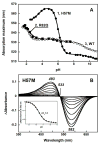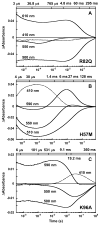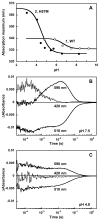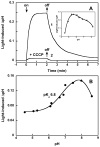Aspartate-histidine interaction in the retinal schiff base counterion of the light-driven proton pump of Exiguobacterium sibiricum
- PMID: 22738070
- PMCID: PMC3415241
- DOI: 10.1021/bi300409m
Aspartate-histidine interaction in the retinal schiff base counterion of the light-driven proton pump of Exiguobacterium sibiricum
Abstract
One of the distinctive features of eubacterial retinal-based proton pumps, proteorhodopsins, xanthorhodopsin, and others, is hydrogen bonding of the key aspartate residue, the counterion to the retinal Schiff base, to a histidine. We describe properties of the recently found eubacterium proton pump from Exiguobacterium sibiricum (named ESR) expressed in Escherichia coli, especially features that depend on Asp-His interaction, the protonation state of the key aspartate, Asp85, and its ability to accept a proton from the Schiff base during the photocycle. Proton pumping by liposomes and E. coli cells containing ESR occurs in a broad pH range above pH 4.5. Large light-induced pH changes indicate that ESR is a potent proton pump. Replacement of His57 with methionine or asparagine strongly affects the pH-dependent properties of ESR. In the H57M mutant, a dramatic decrease in the quantum yield of chromophore fluorescence emission and a 45 nm blue shift of the absorption maximum with an increase in the pH from 5 to 8 indicate deprotonation of the counterion with a pK(a) of 6.3, which is also the pK(a) at which the M intermediate is observed in the photocycle of the protein solubilized in detergent [dodecyl maltoside (DDM)]. This is in contrast with the case for the wild-type protein, for which the same experiments show that the major fraction of Asp85 is deprotonated at pH >3 and that it protonates only at low pH, with a pK(a) of 2.3. The M intermediate in the wild-type photocycle accumulates only at high pH, with an apparent pK(a) of 9, via deprotonation of a residue interacting with Asp85, presumably His57. In liposomes reconstituted with ESR, the pK(a) values for M formation and spectral shifts are 2-3 pH units lower than in DDM. The distinctively different pH dependencies of the protonation of Asp85 and the accumulation of the M intermediate in the wild-type protein versus the H57M mutant indicate that there is strong Asp-His interaction, which substantially lowers the pK(a) of Asp85 by stabilizing its deprotonated state.
Figures










References
-
- Vishnivetskaya T, Kathariou S, McGrath J, Gilichinsky D, Tiedje JM. Low-temperature recovery strategies for the isolation of bacteria from ancient permafrost sediments. Extremophiles. 2000;4:165–173. - PubMed
-
- Rodrigues DF, Goris J, Vishnivetskaya T, Gilichinsky D, Thomashow MF, Tiedje JM. Characterization of Exiguobacterium isolates from the Siberian permafrost. Description of Exiguobacterium sibiricum sp nov. Extremophiles. 2006;10:285–294. - PubMed
-
- Petrovskaya LE, Lukashev EP, Chupin VV, Sychev SV, Lyukmanova EN, Kryukova EA, Ziganshin RH, Spirina EV, Rivkina EM, Khatypov RA, Erokhina LG, Gilichinsky DA, Shuvalov VA, Kirpichnikov MP. Predicted bacteriorhodopsin from Exiguobacterium sibiricum is a functional proton pump. FEBS Lett. 2010;584:4193–4196. - PubMed
-
- Ovchinnikov YA, Abdulaev NG, Feigina MY, Kiselev AV, Lobanov NA. The structural basis of the functioning of bacteriorhodopsin: An overview. FEBS Lett. 1979;100:219–224. - PubMed
Publication types
MeSH terms
Substances
Grants and funding
LinkOut - more resources
Full Text Sources
Miscellaneous

